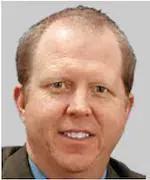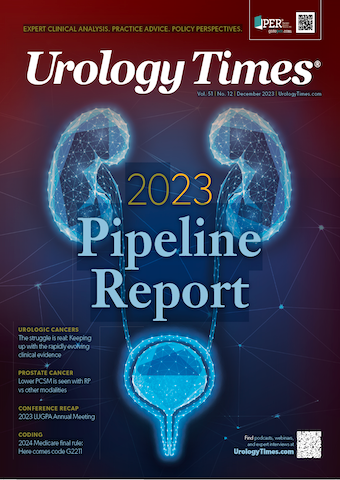Commentary
Article
Urology Times Journal
2024 Medicare final rule: Here comes code G2211
Author(s):
"The conversion factor is slated to undergo a reduction of approximately 3.37% for 2024, decreasing from $33.89 in 2023 to $32.74," write Jonathan Rubenstein, MD, and Mark Painter.
Jonathan Rubenstein, MD

The Centers for Medicare & Medicaid Services (CMS) unveiled the final rule for the Medicare Physician Fee Schedule for 2024 on November 2, 2023.1 The final rule encompasses changes set to take effect January 1, 2024. Most of the changes were an acceptance of the changes proposed in July. In this article, we will provide those changes most relevant to urology, as well as some clarification on the final rules announced.
PHYSICIAN FEE SCHEDULE
Mark Painter

The conversion factor (CF) is slated to undergo a reduction of approximately 3.37% for 2024, decreasing from $33.89 in 2023 to $32.74. This reduction is attributed to several factors: a 0% statutory update, a 2.17% decrease for budget neutrality reasons, and an additional 1.25% decline due to the absence of an increase in the Consolidated Appropriations Act of 2023. The decrease in the CF is partially influenced by the reintroduction of the add-on code G2211, which will be further explored in this article. We are once again left waiting and hoping that Congress will intervene to mitigate the decrease in the CF prior to January 1, 2024.
Changes to evaluation and management (E/M) services will be effective January 1, 2024. is going to implement the add-on health care common procedure coding system code G2211 (Visit complexity inherent to evaluation and management associated with medical care services that serve as the continuing focal point for all needed health care services and/or with medical care services that are part of ongoing care related to a patient’s single, serious condition or a complex condition). This code characterizes the inherent complexity of visits related to the evaluation and management of medical care services that serve as a continuous focal point for comprehensive health care needs. It also applies to medical care services tied to ongoing care for either a patient’s singular serious condition or a complex condition.
Code G2211 was first proposed by CMS in 2021 as a way to compensate physicians for the extra work required for coordination of care for complex or serious conditions.Congress mandated a delay in implementation of the code until January 1, 2024. The proposed implementation of the code in 2024 included several changes to address issues identified previously. Although CMS received mixed reviews for code G2211 for various reasons, they have elected to proceed with the implementation of the code with the revisions as proposed. They have issued some guidance for use of the code. We will do our best to identify these issues; however, we expect that CMS may issue further clarification if Congress does not move to, once again, block the implementation of the code through subsequent action.
Code G2211 is an add-on code to E/M service codes and cannot be reported without an E/M code for the same date of service. Additionally, CMS has added code G2211 to the approved telehealth service list, including the audio-only list, allowing for the addition of the code for both E/M visits performed with synchronous audio and visual and the time-based audio-only codes 99441, 99442, and 99443. Under the new rules for 2024, CMS is not expecting that the add-on code would be reported with more than 38% of all E/M codes billed initially; however, CMS expects the use of the code will grow over time to be billed with approximately 54% of all E/M codes. (Note: Use of the code is expected to vary significantly by specialty.)
Below are examples of encounters listed by CMS for which the add-on complexity code G2211 is not payable and should not be reported:
• If the E/M service is reported with a payment modifier. CMS included the following in the final rule, “we do not expect the O/O [Office or other Outpatient] E/M visit complexity add-on code to be reported when the O/O E/M visit is reported with payment modifiers such as modifier -25 which describes separately billed visits on the same day as another visit or procedure.”1 Therefore, if modifier -25 is required to report the E/M service due to performance of a procedure or service, the add-on code G2211 should not be reported.
• “When the care furnished during the office/outpatient E/M visit is provided by a professional whose relationship with the patient is of a discrete, routine, or time-limited nature, such as but not limited to:
- a mole removal or referral to a physician for a mole removal;
- for treatment of a simple virus;
- for counseling related to seasonal allergies,
- initial onset gastroesophageal reflux disease
- treatment for a fracture; and
- where comorbidities are either not present or not addressed and/or when the billing practitioner has not taken responsibility for ongoing medical care for that particular patient with consistency and continuity over time, or does not plan to take responsibility for subsequent, ongoing medical care for that particular patient with consistency and continuity over time.”1
CMS expects that code G2211 (Visit complexity inherent to evaluation and management associated with medical care services that serve as the continuing focal point for all needed health care services and/or with medical care services that are part of ongoing care related to a patient's single, serious condition or a complex condition. [add-on code, list separately in addition to office/outpatient evaluation and management visit, new or established] will be reported in addition to an E/M service for the following encounters:
• An E/M visit associated“with medical care services that serve as the continuing focal point for all needed health care services and/or with medical care services that are part of ongoing care related to a patient’s single, serious condition or a complex condition.”
• The E/M encounter is provided to a patient for which the relationship between that patient and the practitioner is such that the practitioner will be the continuing focal point for all the care required by the patient, regardless of the purpose of the specific visit, as the practitioner will need to take into consideration of the long-term relationship even if the visit is focused on a transitive or short-term problem.
• The E/M encounter is provided to a patient for which the relationship between that patient and the practitioner is such that the practitioner will be the continuing focal point for ongoing medical care for a single, serious condition or a complex condition, regardless of the purpose of the specific visit, as the practitioner will need to take into consideration of the long-term relationship even if the visit is focused on a transitive or short-term problem.
In summary, based on the current directives included in the final rule, we offer the following initial guidance for code G2211 for 2024 and will clarify based on adjustments:
• Do not report G2211 on dates of service for which modifier -25 should be appended to the E/M code.
• Do not report G2211 unless an E/M code is reported for the same date of service.
• Do not report G2211 for an encounter for a patient who is not under your ongoing care for a separate single, serious condition or a complex condition for a problem that is transient or potentially transient in nature (eg, initial visit with flank pain, urinary tract infection [UTI], stone).
• Report code G2211 if an E/M visit is reported for a patient for a visit in which you are managing total patient care for a single, serious condition or a complex condition (eg, benign prostatic hyperplasia, cancer of any type, incontinence, renal cyst, recurrent UTI, recurrent stones).
• Report code G2211 if an E/M visit is provided to a patient with a transient or temporary problem (eg, UTI, stone, flank pain) or if you have an established relationship with the patient for whom you are providing ongoing longitudinal care, even if it is unrelated or potentially related to the transient problem being treated.
Reimbursement for code G2211 with geographic modification is set at $16.04. Based on the current requirements, documentation would need to support the 3 general types of visits that qualify for reporting of code G2211:
1. Documentation for an E/M visit focused on total care for the patient requiring ongoing care or ongoing care for a single, serious condition or a complex condition should not require additional documentation specific to the code but should include clear direction and a care plan demonstrating patient return and continued care for the patient and/or condition.
2. Documentation for an E/M visit for which the focus of the visit is unrelated or not obviously related to the treatment of the total patient care should include additional documentation indicating that the patient is returning to the practice outside of the longitudinal care being provided, but it does not appear to require that one directly address the long-term care issue that is the reason for the ongoing relationship between the practitioner and the patient.
3. Documentation for an E/M visit for which the focus of the visit is unrelated or not obviously related to the treatment of the single, serious condition or complex condition should include additional documentation indicating that the patient is returning to the practice outside of the longitudinal care being provided, but it does not appear to require that one directly address the long-term care issue that is the reason for the ongoing relationship between the practitioner and the patient.
Billing for code G2211 is to be implemented in a fashion that does not affect the practice ability to provide services and separately report principal care management or chronic care management, which may continue to be reported. In the urology office, the implementation of the code will require changes for both the billing and clinical staff. A list of systems and areas we project will need to be addressed if the code is implemented as proposed is as follows:
• Primary responsibility for reporting code G2211 will likely fall to clinical staff. Training surrounding documentation and communicating the use of G2211 will need to be developed and provided to clinical staff.
• Electronic health record template refinement and billing communication will need to be developed.
• Billing team education for payer-specific reporting and situational reporting will need to be developed and conducted.
• Practice management scrubber updates, including modifier flags, and payer-specific rules should be considered.
• Data review protocols may also be used to assist billing based on previous patient interactions and billing patterns, as well as provide double-checks for appropriate use.
• Compliance reviews with follow-up education should be developed and implemented.
SPLIT/SHARED SERVICES
CMS will delay the change requiring the split/shared services policy to be determined solely by the qualified health professional spending the most time with the patient on the date of service for 1 more year, until 2025. A revised split/shared visit guideline has been added to the American Medical Association (AMA) Current Procedural Terminology 2024 Manual, which includes instructions for medical decision-making (MDM) or time as defining the substantiative portion. Time may be used if both practitioners note E/M time spent and must be used if time is used to select the level of service reported. If MDM is used to determine the level of service, billing under the physician is deemed appropriate if the physician clearly documents the presenting problem, data reviewed, and used in creating the plan of care and documenting the plan of care. Simply documenting review and agreement with MDM will not be sufficient. CMS has agreed to adopt this AMA guideline.
GEOGRAPHIC PRACTICE COST INDEX
The mandated geographic practice cost index (GCPI) floor of 1.0 that was extended through 2023 is now set to expire. Medicare provides a Geographic Adjustment Factor (GAF) each year to estimate the impact of changes in the GCPI for each location for which a GCPI is published. The GAF applies a formula that takes into account past billing to Medicare to adjust the impact to Work, PE (Practice Expense), and MP (Mal-Practice) GCPI change. This projection will not provide an accurate impact of the GCPI changes for urology or for a specific practice. However, as a general projection, the impact should be considered and the GAF is a reasonable starting point. Medicare has assigned 109 different Locations for 2024.The retirement of the GCPI floor will impact Medicare payments for each location differently. 72 regions will see a decrease in Medicare reimbursement between 0.1% and 2.6%, in addition to the decrease caused by the CF as noted above and any changes to relative value units (RVUs) as noted below.Five locations will not be affected by changes for 2024, and 32 locations will see an increase in payment between 0.1% and 2.6%. We encourage you to review the GAF and GCPI addenda to better assess the impact to your practice. The addenda can be downloaded for the CMS website at https://www.cms.gov/medicare/medicare-fee-service-payment/physicianfeesched/pfs-federal-regulation-notices/cms-1784-f
COST RVU CHANGES
Medicare projects that RVU changes for urology will result in a 1% increase in overall RVU production on a similar volume of services, including the addition of code G2211. Although there will be several small adjustments to RVUs in urology, only postvoid residual in the office setting is changing more than 5% up or down, going from a 0.32 nonfacility total in 2023 to a nonfacility total of 0.34 in 2024.
TELEHEALTH
Although the COVID-19 Public Health Emergency (PHE) has expired, the Consolidated Appropriations Act of 2023 required Medicare to extend coverage of telehealth under PHE rules until December 30, 2024. CMS has finalized in this rule that Medicare will continue to cover telehealth next year as they are currently. CMS took the additional step of finalizing to pay telehealth services provided to the patient in the home at the nonfacility rate. This means that in 2024, if Place of Service Code 10 is used to report services provided, telehealth services provided while the patient is in their home will be paid the same amount as what would have been paid to the physician if the patient were in the office.
CMS will continue all coverage of services provided in the office setting by support staff “incident to” the physician if the physician is available via audio and visual remote connection while the service is provided. CMS will also continue to cover telephone-only services 99441 through 99443 in 2024.
MIPS/MEDICARE ACCESS AND CHIP REAUTHORIZATION ACT OF 2015
CMS finalized the threshold for the Merit-based Incentive Payment System (MIPS) for 2024 to remain at 75 points. The penalty for not meeting the threshold is –9% of Medicare payments for MIPS-eligible physicians. CMS cited the COVID-19 PHE and lack of data prior to the pandemic as reasons for not finalizing its proposed shift to 82 points. Although most urology practices are above the threshold, the delay in this change is welcome.
APPROPRIATE USE CRITERIA
CMS has suspended its efforts to implement the Appropriate Use Criteria.
WATCH AND WAIT
We will once again hope for some intervention from Congress to help mitigate the updates to the conversion factor and the GCPI changes.
REFERENCE
Centers for Medicare & Medicaid Services. Medicare and Medicaid programs; CY 2024 payment policies under the Physician Fee Schedule and other changes to Part B payment and coverage policies; Medicare shared savings program requirements; Medicare Advantage; Medicare and Medicaid provider and supplier enrollment policies; and basic health program. Federal Register. November 16, 2023. Accessed November 17, 2023. https://www.federalregister.gov/documents/2023/11/16/2023-24184/medicare-and-medicaid-programs-cy-2024-payment-policies-under-the-physician-fee-schedule-and-other



























